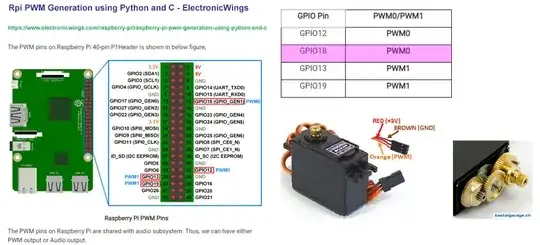Question
For loop to move servo BCM mode GPIO pin #22 does not work. Why?
Short Answer
Well, I think you are using the wrong pin. BCM GPIO Pin #22 cannot do PWM. See the chart in the long answer below.
Long Answer
I suggest to first write the following little test function.
def sequentialMoveServo(positionList)
for position in positionList
if (position > 0) AND (position < 180)
moveServo(position)
else
pass
return
Then we can the function like below:
sequentialMoveServo([+30, +45, -20, +180, +230])
The servo should move sequentially to the positions as below:
30, 45, and 150 degrees, skipping -20 and +230 degrees
Servo research notes
I read the tutorial "Raspberry Pi Servo Motor Control" and find everything OK. The tutorial uses the TowerPro MG996R servo. I remember I also used the same servo a couple of years ago, using Arduino. I am going to search my junk box to find one.
I luckily found one MG996R. I then skimmed the datasheet and find it OK. I moved to tutorials by SparkFun, SourceForge, and Electronic Wing, and found them good. The AdaFruit's tutorials as usual are for Arduino guys. So I skipped Lady Ada, ...
I found ElectronicWing's picture on PWM pins assignment very good. So I borrowed them and pasted here.

I found Rpi ahs 4 PWM pins. I decided to use Pin 18 to test the water. Below is the hardware setup.

Now I have debugged a python program to do the following.
Set GPIO pin 18 high for 2 seconds, to switch on Blue LED to full brightness.
Set the same GPIO pin 18 to output PWM of 1kHz, 50% duty cycle, to switch on/off Blue LED to result half brightness.
# Servo_test32 tlfong01 2019may12hkt1506 ***
# Raspbian stretch 2019apr08, Python 3.5.3
import RPi.GPIO as GPIO
from time import sleep
# *** GPIO Housekeeping Functions ***
def setupGpio():
GPIO.setmode(GPIO.BCM)
GPIO.setwarnings(False)
return
def cleanupGpio():
GPIO.cleanup()
return
# *** GPIO Input/Output Mode Setup and High/Low Level Output ***
def setGpioPinLowLevel(gpioPinNum):
lowLevel = 0
GPIO.output(gpioPinNum, lowLevel)
return
def setGpioPinHighLevel(gpioPinNum):
highLevel = 1
GPIO.output(gpioPinNum, highLevel)
return
def setGpioPinOutputMode(gpioPinNum):
GPIO.setup(gpioPinNum, GPIO.OUT)
setGpioPinLowLevel(gpioPinNum)
return
# *** GPIO PWM Mode Setup and PWM Output ***
def setGpioPinPwmMode(gpioPinNum, frequency):
pwmPinObject = GPIO.PWM(gpioPinNum, frequency)
return pwmPinObject
def pwmPinChangeFrequency(pwmPinObject, frequency):
pwmPinObject.ChangeFrequency(frequency)
return
def pwmPinChangeDutyCycle(pwmPinObject, dutyCycle):
pwmPinObject.ChangeDutyCycle(dutyCycle)
return
def pwmPinStart(pwmPinObject):
initDutyCycle = 50
pwmPinObject.start(initDutyCycle)
return
def pwmPinStop(pwmPinObject):
pwmPinObject.stop()
return
# *** Test Functions ***
def setHighLevelGpioPin18():
print(' Begin setHighLevelGpioPin18, ...')
gpioPinNum = 18
sleepSeconds = 2
setupGpio()
setGpioPinOutputMode(gpioPinNum)
setGpioPinHighLevel(gpioPinNum)
sleep(sleepSeconds)
cleanupGpio()
print(' End setHighLevelGpioPin18, ...\r\n')
return
def setPwmModeGpioPin18():
print(' Begin setPwmModeGpioPin18, ...')
gpioPinNum = 18
sleepSeconds = 10
frequency = 1000
dutyCycle = 50
setupGpio()
setGpioPinOutputMode(gpioPinNum)
pwmPinObject = setGpioPinPwmMode(gpioPinNum, frequency)
pwmPinStart(pwmPinObject)
pwmPinChangeFrequency(pwmPinObject, frequency)
pwmPinChangeDutyCycle(pwmPinObject, dutyCycle)
sleep(sleepSeconds)
pwmPinObject.stop()
cleanupGpio()
print(' End setPwmModeGpioPin18, ...\r\n')
return
# *** Main ***
print('Begin testing, ...\r\n')
setHighLevelGpioPin18()
setPwmModeGpioPin18()
print('End testing.')
# *** End of program ***
'''
Sample Output - 2019may12hkt1319
>>>
RESTART: /home/pi/Python Programs/Python_Programs/test1198/servo_test31_2019may1201.py
Begin testing, ...
Begin setHighLevelGpioPin18, ...
End setHighLevelGpioPin18, ...
Begin setPwmModeGpioPin18, ...
End setPwmModeGpioPin18, ...
End testing.
>>>
>>>
'''
The blue LED switch on full and half bright. So far so good. I am going to use a scope to check out if the PWM waveform is clean and sharp.
Ah, Sunday afternoon tea time, see you later, ... :)
Now I am checking out the timing requirements of the servo.

Now I know that the timing for servo to move to middle position is 50Hz, 7%, 1.4mS. So I wrote the test function below, and checked the output.
def servoPwmBasicTimingTestGpioPin18():
print(' Begin servoPwmBasicTimingTestGpioPin18, ...')
gpioPinNum = 18
sleepSeconds = 120
frequency = 50
dutyCycle = 7
setupGpio()
setGpioPinOutputMode(gpioPinNum)
pwmPinObject = setGpioPinPwmMode(gpioPinNum, frequency)
pwmPinStart(pwmPinObject)
pwmPinChangeFrequency(pwmPinObject, frequency)
pwmPinChangeDutyCycle(pwmPinObject, dutyCycle)
sleep(sleepSeconds)
pwmPinObject.stop()
cleanupGpio()
print(' End servoPwmBasicTimingTestGpioPin18, ...\r\n')
return
Pin18 PWM output looks good.

Now I can implement the following condition/action table
Condition Action Table
Middle condition = servo moves to Middle action
Leftmost = servo moves to LeftMost action
RightMost condition = servo moves to RightMost action
I have written a little program to loop the above conditions, as show in the following youTube.
Condition Servo Action Program YouTube Demo
/ servo research notes to continue, ...
References
Raspberry Pi Servo Motor control - Rpi Tutorials
Servo MG996R Datasheet - TowerPro
Python (RPi.GPIO) API - SparkFun
Using PWM in RPi.GPIO - SourceForge
Raspberry Pi PWM Generation using Python and C - ElectronicWing
Servo Tutorial - Lady Ada
PWM Tutorial - Lady Ada
Servo Motors Using Arduino - AdaFruit



